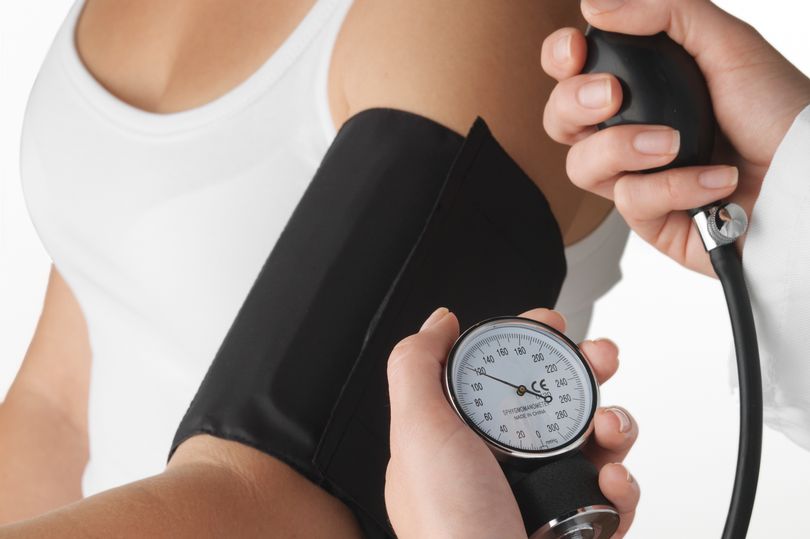Lowering blood pressure is vital for living a longer, healthier life. Here are our best tips on how to make the necessary changes.
Half the people suffering from high blood pressure don’t know they have it.
Symptoms are hard to spot but if left untreated, could increase your risk of heart attack or stroke.
We have revealed ten lifestyle changes you can make and how to lower blood pressure.
How to lower blood pressure
1. Exercise
Try to work out for at least half an hour a day. How about walking, running, swimming, cycling or dancing?
If your blood pressure is slightly raised, exercise can prevent you from developing full-blown hypertension.
Blood pressure is measured in mmHg – mm of mercury, the height blood pressure pushes up a column of mercury. Regular exercise can lower it by up to 9mmHg.

Working out for just 30 minutes a day can cut your risk of hyper tension
2. Don’t stress
Chronic stress can lead to high blood pressure and even stressing out now and again can contribute by making you eat badly, drink or smoke.
Try to accept things you can’t change and plan how to solve problems you can. Avoid stress triggers and take 15 minutes out of your day to sit quietly and breathe deeply.
3. Take magnesium
The mineral may help lower your blood pressure, as research found people with the highest intakes are a third less likely to have a heart attack or stroke. Nuts, seeds, green leaves and dark chocolate are great sources.

Dark chocolate is a good source of magnesium
4. Lose weight
As you get bigger, your blood pressure often follows suit and if you are overweight you could suffer from disrupted breathing when you sleep, which is also linked to hypertension.
Check your BMI to make sure you are a healthy weight and watch your waist – men are at risk if their waist measures more than 40in and women over 35in. The good news is losing just 10lb can help.
5. Cut down on salt
Adults should eat no more than 6g of salt a day – that’s about one teaspoon. People over 50, diabetics and those with kidney disease are more sensitive to sodium. Check labels, eat less processed food and taste food before adding salt.

Reduce your daily intake of salt
6. Get enough sun
Studies have found exposure to sunshine increases production of nitric oxide, which dilates arteries.
The vitamin D sun produces also lowers blood pressure and can reduce the risk of stroke.
7. Watch the coffee
Caffeine causes a short but dramatic blood pressure spike.
You may need to reduce your intake of tea, coffee and soft drinks if you are particularly sensitive to it.

Your cup of coffee could cause your blood pressure to spike dramatically
8. Quit the habit
Every cigarette you smoke hikes your blood pressure for many minutes after you stub it out.
So lengthen your life by quitting and help your blood pressure return to normal.
9. Eat well
Your diet should be rich in fruit, veg and wholegrains, avoiding saturated fat and cholesterol.
Writing down what you eat can help shed light on what you are actually putting away. And don’t stop being good when you head out for a meal – opt for healthy choices on restaurant menus.

Eating healthily can help the health of your heart too
10. Drink less booze
Heavy drinking can increase your risk of hypertension – and mean you put on weight. Do not drink more than 14 units a week.
Necking more than a drink a day for those over 65 could raise blood pressure dramatically. Plus it reduces the effectiveness of any medication you are taking to counter it.
But a tiny amount could actually help reduce the risk.
How to spot the danger signs

Blood pressure is recorded with two numbers representing the systolic pressure and diastolic pressure.
The systolic (higher number) is the force at which your heart pumps blood around your body. The diastolic (lower number) is the resistance to the blood flow in the blood vessels.
Both are measured in millimetres of mercury (mmHg). Ideal blood pressure is between 90/60mmHg and 120/80mmHg. Low blood pressure is 90/60mmHg or lower. High blood pressure is 140/90mmHg or higher.
If your reading is between 120/80mmHg and 140/90mmHg, you could be at risk of developing high blood pressure if you don’t take steps to keep it under control.
All adults over 40 are advised to have a blood pressure test every five years.
You can do this at your GP surgery, some pharmacies, as part of your NHS Health Check, in some workplaces or by using a home blood pressure monitor.
Three easy ways to get these nutrients into your diet
Build these three tasty menu plans, devised by Mary, into your week to get pressure-fighting nutrients into your diet.
PLAN 1… Breakfast: Porridge with berries, walnuts and ground flaxseeds. Snack: Pomegranate and natural yoghurt topped with pumpkin seeds. Lunch: Chicken and beetroot salad with quinoa, sprinkled with sesame seeds. Afternoon snack: Handful of raw cashews. Dinner: Baked trout, cabbage stir-fried in ginger, garlic and sesame seeds, brown rice.
PLAN 2… Breakfast: Spinach and tomato omelette. Snack: Handful of raw walnuts. Lunch: Chickpea, sweet potato and kale soup, with oatcakes. Afternoon snack: Four celery sticks, 1 tbsp houmous. Dinner: Oven-roasted salmon with roasted beetroot, sprouts, garlic and onions. Season with dried herbs and olive oil instead of salt.
PLAN 3… Breakfast: Natural yoghurt with cinnamon, berries, ground flaxseeds and chopped nuts. Snack:
2 oatcakes with cashew nut butter. Lunch:Lentil and veg soup with. Afternoon snack: Celery or carrot sticks dipped in plain cottage cheese. Dinner: Cauliflower and chickpea curry, brown rice.












